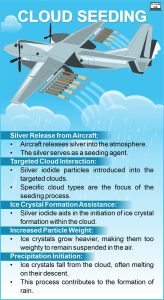10 Nov Cloud Seeding
This article covers “Daily Current Affairs” and the topic details “ Cloud Seeding”. This topic has relevance in the Science and Technology section of the UPSC CSE exam.
GS 3: Science and Technology
Why in the news?
Delhi is considering the implementation of artificial rain techniques as a measure to address the escalating air pollution levels.
Overview of Cloud Formation:
- Comprised of minuscule water droplets or ice crystals.
- Form when atmospheric water vapor cools and condenses around particles like dust or salt.
- Water droplets or ice crystals require condensation or ice nuclei.
- Without these particles, precipitation in the form of raindrops or snowflakes cannot occur.
Cloud Seeding:
- Artificial method to boost rainfall by introducing specific substances into clouds.
- Aircraft release chemicals (e.g., silver iodide, potassium iodide, dry ice) into the atmosphere.
- Attracts water vapor, leading to the formation of rain clouds.
- Takes approximately half an hour for cloud seeding to induce rainfall.
Cloud Seeding Techniques:
- Hygroscopic Cloud Seeding:
- Objective: Accelerate droplet coalescence in liquid clouds.
- Seeding agents act as efficient cloud condensation nuclei (CCN) or Giant Cloud Condensation Nuclei (GCCN).
- Strengthens condensation and collision–coalescence process, increasing precipitation efficiency.
- Glaciogenic Cloud Seeding:
-
- Centers on prompting the generation of ice in clouds that exist in a supercooled state.
- Involves dispersing efficient ice nuclei (e.g., silver iodide, dry ice) into the cloud.
- Enhances ice particle production, leading to increased rainfall.
Utility of Cloud Seeding:
- Reducing drought impact.
- Forest fire prevention.
- Augmenting precipitation levels.
- Improving air quality.

Success Story: Cloud Seeding Experiment in Solapur:
- Location: Solapur city, known for low rainfall on the leeward side of the Western Ghats.
- Outcome: Achieved an 18% relative enhancement in rainfall through a cloud seeding experiment.
SOURCE:https://indianexpress.com/article/explained/explained-sci-tech/delhi-rain-cloud-seeding-pollution-explained-9021286/
Download plutus ias current affairs eng med 10th Nov 2023
Q.1 In the context of which of the following scenarios do some scientists propose the utilization of cirrus cloud thinning technique and the introduction of sulfate aerosol into the stratosphere? (2019)
(a) Initiating artificial rains in specific regions.
(b) Mitigating the frequency and severity of tropical cyclones.
(c) Alleviating the detrimental impacts of solar wind on Earth.
(d) Mitigating global warming.
Q.2 Regarding cloud seeding or artificial rain techniques, evaluate the following statements:
- It is a synthetic method aimed at diminishing condensation nuclei in the atmosphere.
- Utilizes substances such as silver iodide, potassium iodide, and sulfate aerosols.
- It amplifies the collision–coalescence mechanism of droplets, thereby promoting increased precipitation.
How many of the above statement/s is/are correct?
(a) Only one
(b) Only two
(c) All three
(d) None
.
Q.3 Discuss the role and ethical considerations associated with implementing large-scale geoengineering projects as a strategy to mitigate the effects of climate change.



No Comments